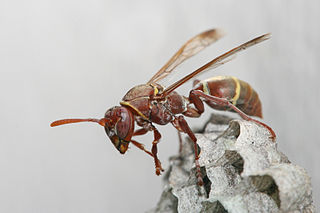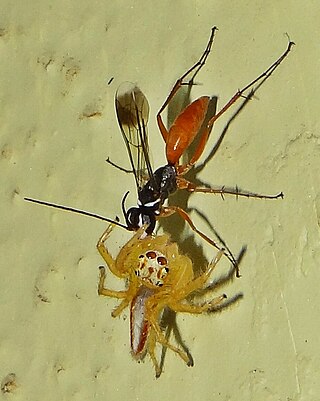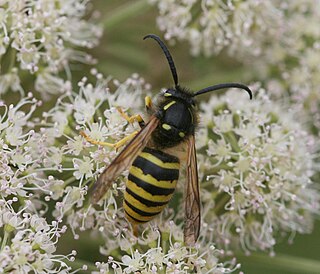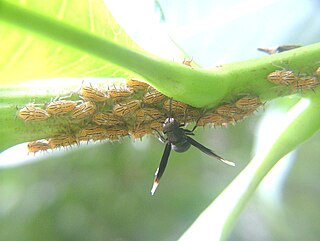
The Polistinae is a subfamily of eusocial wasps belonging to the family Vespidae. They are closely related to the wasps and true hornets of the subfamily Vespinae, containing four tribes. With about 1,100 species total, it is the second-most diverse subfamily within the Vespidae, and while most species are tropical or subtropical, they include some of the most frequently encountered large wasps in temperate regions.

Honey wasps are species in the genus Brachygastra of the family Vespidae. Brachygastra comprises 17 species of social paper wasps. The ancestral species are thought to have diverged about 32 million years ago within diverse Amazonian rainforest. Subsequent speciation within the genus is thought to have mostly occurred between 23 Ma and 10 Ma, during the time of the Andean uplift when the landscape was significantly altered due to tectonic activity. The current cladistic organisation of the genus has been heavily reliant on morphological characteristics.

Brachygastra mellifica, commonly known as the Mexican honey wasp, is a neotropical social wasp. It can be found in North America. B. mellifica is one of few wasp species that produces honey. It is also considered a delicacy in some cultures in Mexico. This wasp species is of use to humans because it can be used to control pest species and to pollinate avocados.

Mass provisioning is a form of parental investment in which an adult insect, most commonly a hymenopteran such as a bee or wasp, stocks all the food for each of her offspring in a small chamber before she lays the egg. This behavior is common in both solitary and eusocial bees, though essentially absent in eusocial wasps.

The tree wasp is a species of eusocial wasp in the family Vespidae, found in the temperate regions of Eurasia, particularly in western Europe. Despite being called the tree wasp, it builds both aerial and underground paper nests, and can be found in rural and urban habitats. D. sylvestris is a medium-sized wasp that has yellow and black stripes and a black dot in the center of its clypeus. It is most common to see this wasp between May and September during its 3.5 month colony cycle.

The Central American paper wasp is a nocturnal eusocial wasp. It is famous for its swarm based emigration behavior, and is native to the lowlands of Central and northern South America. This species has developed special night vision adaptations to facilitate their night-time swarming and foraging behavior and has important medicinal properties for the Pankararú people of Brazil.
Apoica flavissima is a paper wasp found primarily in South America. The species is distinguishable by its light coloring, unique single comb nests, and nocturnal nature. A notable feature of this species is the size dimorphism between queens and workers. Unlike most Vespidae wasps, Apocia flavissima queens are smaller than their worker counterparts which results in unique intraspecies relationships.

Agelaia vicina is a species of wasp in the genus Agelaia. They are neotropical social wasps known to have the largest colony sizes and nest sizes among social wasps, with some colonies exceeding over one million individuals. They are predators of land arthropods, consuming both insects and spiders alike. Recent sperm morphology studies have shown that although Vespidae belong to the superfamily Vespoidea, A. vicina may be more phylogenetically related to Apoidea.

Synoeca cyanea, commonly known as the marimbondo-tatu in Brazil, is a swarm-founding eusocial wasp. Native to Brazil and Argentina, S. cyanea is one of the largest and most aggressive species of social wasps and is feared in many rural areas. It begins its colony cycle in the early spring and continues until nest abandonment. Throughout its life, S. cyanea forage sugary substances and animal carcasses for food and wood pulp for its nest. S. cyanea is also known for its strong venom, which is enough to cause haemolytic activity.

Agelaia pallipes is a species of social paper wasp found from Costa Rica to Brazil, Argentina and Paraguay. A. pallipes is ground-nesting and is one of the most aggressive wasps in South America. This species is a predator of other insects, including flies, moths, and ground crickets, as well as baby birds.

Protonectarina sylveirae, commonly referred to as the Brazilian wasp, is a neotropical swarm-founding wasp species that ranges widely across South America. This species relies heavily on the consumption of animal protein rather than nectar. P. sylveirae preys heavily on agricultural pests to coffee crops, keeping pest populations low.

Leipomeles dorsata is a neotropical paper wasp that is found across Central America and northern South America. It is a eusocial wasp with little differentiation between reproducing and non-reproducing females. In fact, workers can become temporary reproductives if the main reproductives are killed, allowing reproduction to continue until the main reproductive population recovers. The colony cycles through different ratios of main reproductive females and subordinate reproductive females, starting with few or no primary reproducing females, and increasing until there are only main reproductives.
Protopolybia exigua is a species of vespid wasp found in South America and Southern Brazil. These neotropical wasps, of the tribe Epiponini, form large colonies with multiple queens per colony. P. exigua are small wasps that find nourishment from nectar and prey on arthropods. Their nests are disc-shaped and hang from the undersides of leaves and tree branches. This particular species of wasp can be hard to study because they frequently abandon their nests. P. exigua continuously seek refuge from phorid fly attacks and thus often flee infested nests to build new ones. The wasps' most common predators are ants and the parasitoid phorid flies from the Phoridae family.

Polybia sericea is a social, tropical wasp of the family Vespidae that can be found in South America. It founds its colonies by swarming migrations, and feeds on nectar and arthropods.

Synoeca surinama is a Neotropical swarm-founding wasp of the tribe Epiponini. It is known for its metallic blue and black appearance and painful sting. S. surinama builds nests on tree trunks and can be found in tropical climates of South America. When preparing to swarm, there are a number of pre-swarming behaviors that members of S. surinama colonies partake in, such as buzzing runs and occasional brood cannibalism. In S. surinama, social environmental conditions determine the caste ranks of individuals in the developing brood. Unlike less primitive Hymenoptera species, S. surinama display little morphological variation between egg laying queens and workers. S. surinama wasps visit flowering plants and are considered pollinators. When these wasps sting, the stinger is left in the victim and the wasp ultimately dies.
Parachartergus fraternus is a neotropical, swarm founding, polistine wasp species that is distributed throughout Central and South America. They live in nests in second growth tropical dry forests, near pasture fields, roadside areas, and urban areas as well. These wasps eat insects, such as caterpillars of Lepidoptera. They also drink nectar, honeydew, and water. The workers capture their prey during foraging. They also use venom to paralyze their prey in order to consume it later. P. fraternus wasps are not very aggressive and they do not attack when the nest is approached.
Brachygastra scutellaris, a honey wasp, is a Neotropical, swarm-founding species that is found in South America and has a medium-sized population of 100–1000 individuals per colony. It stores large amounts of nectar in its nest for the production of honey, and it was even found that at certain times of the year, the nectar is toxic to humans, as they will extract nectar from hallucinogenic plants, depending on the season.
Protopolybia chartergoides, also known as Pseudochartergus chartergoides, is a species of wasp within the genus Protopolybia. It is a social wasp found in southern Central America and northern South America.

Mischocyttarus mexicanus cubicola is a neotropical subspecies of paper wasp found in the New World. It is a social wasp that demonstrates two different types of nesting strategies, depending upon context. This context-dependent trait makes Mischocyttarus mexicanus cubicola a good model to study social biology within social wasps. In detail, this trait allows for the females of this species to form nests both individually and as co-founders with other females within the same colony. This subspecies is also known to exhibit cannibalism, with M. m. cubicola queens feeding on their own larvae for nourishment when unaided by workers.

Parachartergus is a genus of epiponine social wasps belonging to the subfamily Polistinae. Species include:

















